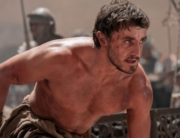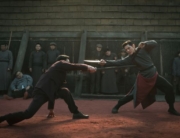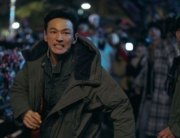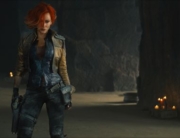With pomp, pageantry, and pulp, director Robert Eggers and the Icelandic writer Sjón have mashed up the bare bones of Hamlet’s revenge plot with Norse mythology. The result may be the most Wagnerian film to come down the pipeline in forever, with the appearances of Valkyries, the veneration of Norse gods, and a sword of the “most secretive rare iron”—not Richard Wagner’s famed Nothung but here called the Night Blade.
If you were to compare The Northman’s script to the score of “The Ring Cycle,” the film echoes the most bombastic and militaristic moments of Wagner’s four operas. Yet only in Götterdämmerung does revenge become the prime motivator. Here, it’s the sole engine that pulses throughout the entire proceedings. The bloodletting plays out like a compact season of Vikings and Game of Thrones, with the emphasis on action above all else.
In 895 AD, a young princeling of a North Atlantic kingdom, Amleth (Oscar Novak), witnesses the slaughter of his warrior father, King Aurvandil War-Raven (Ethan Hawke). The culprit: Aurvandil’s bastard half-brother Fjölnir (hunky Claes Bang, almost unrecognizable from The Square), who also carries away the 12-year-old’s mother, Queen Gudrún (Nicole Kidman). Twenty years later, Amleth, now played by a bulked-up Alexander Skarsgård, has escaped Fjölnir’s henchmen, blending in as a part of a tribe raping and pillaging through what is now Ukraine. Among the wreckage of a burned-out village, he encounters a witch (Björk), who sternly reminds him he can’t flee from fate: he has a duty to avenge his father’s murder. Without hesitation, he brands himself with an iron stoker as part of his slave disguise and stows away on a ship heading to Iceland, where his uncle, the usurper to his father’s throne, has settled down to the farming life.
The filmmakers have their eyes on the kill(s) and rarely take their focus off the ball. All else is given short shrift, though there is a love story between the Amleth and the enslaved Olga of the Birch Forest (Anya Taylor-Joy)–because she’s the only blonde, she’s highly coveted by Fjölnir. Given the many long-winded names, the entire cast plays it straight, humorlessly, and without mercy. They are even fluent in Epic Speak, keeping a stern face with dialogue such as, “This distempered spirit will strike again.”
For its first half hour, the script becomes an equal partner with the production and sound design in its world building; the dialogue would feel out of place in any other film. However, with barely any variation in its kill-or-be-killed worldview, the screenplay pushes aside explorations of other themes—family ties be damned. Brawn beats brains, though through the machinations of Olga, who practices earth magic, and Gudrún, women have a say in the mayhem. (Strangely, the women speak with a similar Lady Gaga-gone-Gucci accent, though one is Slavic and the other from Brittany.) So, any connection to Hamlet is severed: gone is the self-doubt, introspection, or ambiguity. Psychological probing is squashed, like many onscreen skulls. It all leads to a slog of a saga of slaughter.
Filmed in Iceland and mostly in Northern Ireland, with a varied color palette for its far-flung settings, the beautiful images and scenery offer a needed respite from the intestine-spilling violence. If you do see The Northman in theaters, make sure it’s in Dolby Atmos and Dolby Vision for the full effect of its rich colors and ambient sound design.
That said, a more gut-wrenching and involving tale based upon Norse mythology was made nearly 100 years ago: Fritz Lang’s Die Nibelungen: Kriemhild’s Revenge (1924), which centered on the murder of the heroic Siegfried. So, it’s possible to bring these mythic characters sincerely to life, vulnerabilities and all, even at the slower pace of a silent movie.







Leave A Comment